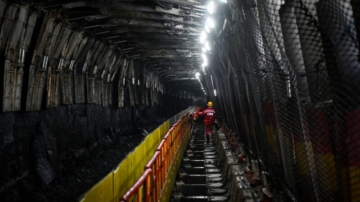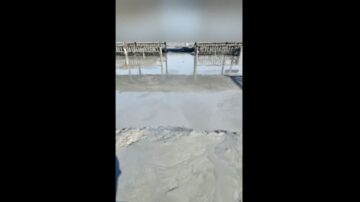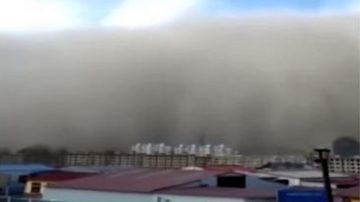【新唐人2014年08月04日訊】在大陸南方多省經歷嚴重洪澇災害的同時,河南、河北等12個省份則正在經歷幾十年未見的嚴重旱災,部份地區已斷水3個月。專家分析,多年來大陸當局片面追求經濟高速增長,水資源等自然環境被嚴重破壞,從「三峽大壩」到「南水北調」,無一不給周邊生態帶來巨大的負面影響。
今年入夏以來,河南、河北、山西、陝西、湖北、內蒙、新疆等12省區持續高溫少雨,出現了幾十年未見的旱災。其中,陝西遭遇53年來最嚴重乾旱,河南省則遭遇63年來的最嚴重乾旱,部份地區已斷水3個月。
大陸媒體報導,截至7月30號,12省區作物受旱面積超過了7,200萬畝,受影響牲畜達207萬頭。超過160萬人因旱情導致飲水困難。旱情主要集中在河南平頂山、洛陽、漯河、許昌、焦作、河北廊坊、滄州、保定、唐山、陝西渭南等地,其中河南為本次旱災的重災區,受災面積將近全國受災面積的一半。
河南寶豐大營鎮杜先生:「一直都沒有下雨。莊稼都旱死完了。連家裡的飲用水都是用桶拉着、從幾十裡外買着吃的。」
河南寶豐大營鎮杜先生表示,雖然旱情嚴重,老百姓的生活很困難,但當地政府並沒有任何作為,對災情無人問津。
在西安郊區的一位趙姓農民也向《新唐人》介紹了當地的旱情,他還披露當地水利設施被破壞的隱情。
西安郊區農民趙先生:「莊稼都枯死了。很早以前,我們村集體的水利設施、深井都被人為破壞了,破壞了之後,農民種甚麼東西都是絕收。」
這名趙姓農民表示,當地村幹部故意人為將水利設施破壞,迫使農民無法耕種,然後他們再把土地變相倒賣、謀取私利。村民上告無門,非常無奈。
據了解,青藏高原是中國一些重要河流的發源地,但是十多年來的西部大開發,使很多草原受到破壞、土地受到污染,「青藏高原」上已經出現河床乾涸的現象。在中國其它地區也出現類似的問題,比如東北的濕地正被建築業所吞噬。
《美國之音》中文網報導,7月18號美國「塔夫茨大學」中國外交關係副教授薩勒曼汗(Sulmaan Khan)在美國《外交事務》雜誌上撰文指出,中國公眾已經對城市開發,帶來的水資源匱乏、飲用水、土壤受到污染這類問題,感到非常不滿。當局如果不儘快處理水危機,不僅將導致對生態環境的嚴重破壞,更會帶來「慢性自殺」似的災難。
文章談到,中共當局力推的「南水北調」工程將給生態環境帶來很大危險。這個浩大工程會阻斷河流系統,引發土壤流失,反而會加劇水資源的缺乏。但當局至今仍然沒有把保護水資源提到議事日程上來。
中國金融智庫研究員鞏勝利:「南水北調、三峽建設,還有當年蘇聯幫助建設的黃河三門峽電站,都是這種結果。這為後人留下了一個難以解決的災難。」
在此之前,外界曾分析指出,近年來重慶、四川等地接連發生多起地震、泥石流等災害,這在很大程度上,和「三峽大壩」建成之後,對周邊生態環境的破壞有關。
而大陸媒體報導,8月2號至4號,四川盆地、重慶、陝西、山西、河南、湖北等地部份地區最高氣溫可達攝氏37到39度,局部可達40度以上。
7月30號,河南省水文資源局對平頂山、南陽、信陽發佈了枯水預警,預計未來一週仍無有效降雨。而8月中旬前,陝西大部份地區,也持續高溫少雨,旱情將更加嚴重。
採訪/朱智善 編輯/李謙 後製/蕭宇
12Provinces Suffer from Severe Drought
While the south is experiencing severe floods, severest drought
in decades is hitting 12 provinces in China such as Henan,
Hebei and others.
Some areas have been without water for three months.
Experts analyze water and ecology are destroyed at the cost
of rapid economic growth.
Projects such as the Three Gorges Dam and the Water Diversion
are causing huge negative impact to the surrounding ecology.
Severest drought in decades has occurred in 12 provinces
such as Henan, Hebei, Shanxi, Shaanxi, Hubei, Inner Mongolia,
Xinjiang and others the summer of this year.
For instance, Shaanxi suffered its worst drought in 53 years,
Henan suffered the worst one in 63 years.
Some areas have been without water for three months.
Mainland media reported that as of July 30, drought covers
more than 11.9 million acres of farm land,
affecting 2.07 million farm animals.
More than 1.6 million people lack drinking water.
Drought mainly centers in Henan province, accounting for half
of the drought stricken area in the entire nation.
Mr. Du, a resident of Henan: "There has been no rain. All the
crops were dry dead. We have to get drinking water in pails
from tens of miles away, as well as food."
Mr. Du indicates the local government has done nothing to the
disaster despite the severity of the drought and the hardship.
A peasant of Xi'an, Shaanxi province, Mr. Zhao, told NTD TV
about the local drought.
He also revealed that local reservoirs
were deliberately destroyed.
Mr. Zhao: "The crops have withered. The reservoirs and the
wells were ruined intentionally long ago.
Since then, there has been no harvest."
Mr. Zhao explains, since local leaders deliberately
destroyed the irrigation facilities, farming was forced to stop.
The deserted land was then resold and became personal gain
for the village leaders. Villagers were left with nothing.
The Tibetan Plateau, the birthplace of some of China's major
rivers, suffers severe damage and pollution after dozens of
years of exploitation in the west.
Dry riverbeds are widespread in the Plateau.
Similar issues have also occurred to many other areas in China,
such as the northeast wetlands being swallowed up
by real estate development.
Sulmaan Khan, assistant Professor of Chinese
Foreign Relations at Tufts University, described in an article in
Foreign Affairs magazine, "The Chinese public is tired of the
water shortages, unsafe drinking water, and soil contamination
caused by haphazard urban development."
The water shortage is not only a serious damage to the ecology,
but also suicidal.
The article mentioned the water diversion project brings
immense ecological risks.
"It is quite possible that the project will disrupt the river
systems and exacerbate water shortages, rather than solve them,
by triggering soil erosion."
But, Beijing has yet to develop a plan that addresses the entirety
of its environmental woes.
Chinese financial think tank researcher Gong Shengli:
"The water diversion and the Three Gorges dam, as well as the
Sanmenxia power plants built by the Soviet Union,
have resulted in disasters hard to resolve."
Many seismic activities and mud slides in surrounding areas
such as Chongqing, Sichuan and so forth, have been analyzed
to be greatly connected to ecological damage brought
by the Three Gorges Dam.
Temperatures between August 2 and 4 reached as high as
37 to 39 degrees C, and even 40 degrees in the Sichuan Basin,
Chongqing, Shaanxi, Shanxi, Henan, and Hubei.
July 30, Hydrology and Resources Bureau of Henan Province
issued a drought warning: No rainfall is expected next week.
And by mid-August, most parts of Shaanxi will continue under
high temperatures and little rain, the drought will worsen.
Interview/Zu Zhishan Edit/LiQian Post-Production/XiaoYu
今年入夏以來,河南、河北、山西、陝西、湖北、內蒙、新疆等12省區持續高溫少雨,出現了幾十年未見的旱災。其中,陝西遭遇53年來最嚴重乾旱,河南省則遭遇63年來的最嚴重乾旱,部份地區已斷水3個月。
大陸媒體報導,截至7月30號,12省區作物受旱面積超過了7,200萬畝,受影響牲畜達207萬頭。超過160萬人因旱情導致飲水困難。旱情主要集中在河南平頂山、洛陽、漯河、許昌、焦作、河北廊坊、滄州、保定、唐山、陝西渭南等地,其中河南為本次旱災的重災區,受災面積將近全國受災面積的一半。
河南寶豐大營鎮杜先生:「一直都沒有下雨。莊稼都旱死完了。連家裡的飲用水都是用桶拉着、從幾十裡外買着吃的。」
河南寶豐大營鎮杜先生表示,雖然旱情嚴重,老百姓的生活很困難,但當地政府並沒有任何作為,對災情無人問津。
在西安郊區的一位趙姓農民也向《新唐人》介紹了當地的旱情,他還披露當地水利設施被破壞的隱情。
西安郊區農民趙先生:「莊稼都枯死了。很早以前,我們村集體的水利設施、深井都被人為破壞了,破壞了之後,農民種甚麼東西都是絕收。」
這名趙姓農民表示,當地村幹部故意人為將水利設施破壞,迫使農民無法耕種,然後他們再把土地變相倒賣、謀取私利。村民上告無門,非常無奈。
據了解,青藏高原是中國一些重要河流的發源地,但是十多年來的西部大開發,使很多草原受到破壞、土地受到污染,「青藏高原」上已經出現河床乾涸的現象。在中國其它地區也出現類似的問題,比如東北的濕地正被建築業所吞噬。
《美國之音》中文網報導,7月18號美國「塔夫茨大學」中國外交關係副教授薩勒曼汗(Sulmaan Khan)在美國《外交事務》雜誌上撰文指出,中國公眾已經對城市開發,帶來的水資源匱乏、飲用水、土壤受到污染這類問題,感到非常不滿。當局如果不儘快處理水危機,不僅將導致對生態環境的嚴重破壞,更會帶來「慢性自殺」似的災難。
文章談到,中共當局力推的「南水北調」工程將給生態環境帶來很大危險。這個浩大工程會阻斷河流系統,引發土壤流失,反而會加劇水資源的缺乏。但當局至今仍然沒有把保護水資源提到議事日程上來。
中國金融智庫研究員鞏勝利:「南水北調、三峽建設,還有當年蘇聯幫助建設的黃河三門峽電站,都是這種結果。這為後人留下了一個難以解決的災難。」
在此之前,外界曾分析指出,近年來重慶、四川等地接連發生多起地震、泥石流等災害,這在很大程度上,和「三峽大壩」建成之後,對周邊生態環境的破壞有關。
而大陸媒體報導,8月2號至4號,四川盆地、重慶、陝西、山西、河南、湖北等地部份地區最高氣溫可達攝氏37到39度,局部可達40度以上。
7月30號,河南省水文資源局對平頂山、南陽、信陽發佈了枯水預警,預計未來一週仍無有效降雨。而8月中旬前,陝西大部份地區,也持續高溫少雨,旱情將更加嚴重。
採訪/朱智善 編輯/李謙 後製/蕭宇
12Provinces Suffer from Severe Drought
While the south is experiencing severe floods, severest drought
in decades is hitting 12 provinces in China such as Henan,
Hebei and others.
Some areas have been without water for three months.
Experts analyze water and ecology are destroyed at the cost
of rapid economic growth.
Projects such as the Three Gorges Dam and the Water Diversion
are causing huge negative impact to the surrounding ecology.
Severest drought in decades has occurred in 12 provinces
such as Henan, Hebei, Shanxi, Shaanxi, Hubei, Inner Mongolia,
Xinjiang and others the summer of this year.
For instance, Shaanxi suffered its worst drought in 53 years,
Henan suffered the worst one in 63 years.
Some areas have been without water for three months.
Mainland media reported that as of July 30, drought covers
more than 11.9 million acres of farm land,
affecting 2.07 million farm animals.
More than 1.6 million people lack drinking water.
Drought mainly centers in Henan province, accounting for half
of the drought stricken area in the entire nation.
Mr. Du, a resident of Henan: "There has been no rain. All the
crops were dry dead. We have to get drinking water in pails
from tens of miles away, as well as food."
Mr. Du indicates the local government has done nothing to the
disaster despite the severity of the drought and the hardship.
A peasant of Xi'an, Shaanxi province, Mr. Zhao, told NTD TV
about the local drought.
He also revealed that local reservoirs
were deliberately destroyed.
Mr. Zhao: "The crops have withered. The reservoirs and the
wells were ruined intentionally long ago.
Since then, there has been no harvest."
Mr. Zhao explains, since local leaders deliberately
destroyed the irrigation facilities, farming was forced to stop.
The deserted land was then resold and became personal gain
for the village leaders. Villagers were left with nothing.
The Tibetan Plateau, the birthplace of some of China's major
rivers, suffers severe damage and pollution after dozens of
years of exploitation in the west.
Dry riverbeds are widespread in the Plateau.
Similar issues have also occurred to many other areas in China,
such as the northeast wetlands being swallowed up
by real estate development.
Sulmaan Khan, assistant Professor of Chinese
Foreign Relations at Tufts University, described in an article in
Foreign Affairs magazine, "The Chinese public is tired of the
water shortages, unsafe drinking water, and soil contamination
caused by haphazard urban development."
The water shortage is not only a serious damage to the ecology,
but also suicidal.
The article mentioned the water diversion project brings
immense ecological risks.
"It is quite possible that the project will disrupt the river
systems and exacerbate water shortages, rather than solve them,
by triggering soil erosion."
But, Beijing has yet to develop a plan that addresses the entirety
of its environmental woes.
Chinese financial think tank researcher Gong Shengli:
"The water diversion and the Three Gorges dam, as well as the
Sanmenxia power plants built by the Soviet Union,
have resulted in disasters hard to resolve."
Many seismic activities and mud slides in surrounding areas
such as Chongqing, Sichuan and so forth, have been analyzed
to be greatly connected to ecological damage brought
by the Three Gorges Dam.
Temperatures between August 2 and 4 reached as high as
37 to 39 degrees C, and even 40 degrees in the Sichuan Basin,
Chongqing, Shaanxi, Shanxi, Henan, and Hubei.
July 30, Hydrology and Resources Bureau of Henan Province
issued a drought warning: No rainfall is expected next week.
And by mid-August, most parts of Shaanxi will continue under
high temperatures and little rain, the drought will worsen.
Interview/Zu Zhishan Edit/LiQian Post-Production/XiaoYu








